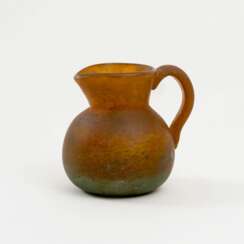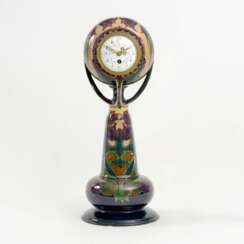
Art nouveau and Design — Auktion Kunst und Antiquitäten

Max Esser was a German sculptor and designer, celebrated for his intricate animal sculptures and porcelain figurines. Born in 1885, Esser's career was marked by his detailed and lifelike representations of animals, which garnered significant acclaim and recognition in the art world.
Max Esser's education at the Kunstgewerbemuseum Berlin and the Berlin Art Academy honed his skills in sculpture, leading to regular exhibitions at the Great Berlin Art Exhibition from 1906. His works, often characterized by their expressive nature and technical precision, reflect his deep understanding of animal anatomy and movement.
Several of Max Esser's works are held in prestigious collections, such as the Metropolitan Museum of Art. Notably, his chess set at the Met, featuring materials like silver, ivory, and ebony, showcases his versatility and craftsmanship. This set is adorned with zodiac and astrological symbols, adding a layer of depth and intrigue to each piece.
Max Esser's works have also been featured in numerous auctions, with pieces like his bronze birds and Meissen porcelain figurines achieving significant attention and high bids. His 'Eagle' figurine for Meissen, made in 1931, is a testament to his skill with porcelain, capturing the majesty and fierceness of the eagle in a delicate medium.
For collectors and experts in art and antiques, the works of Max Esser offer a blend of historical value and exquisite artistry. His contributions to porcelain art and animal sculpture remain influential, continuing to inspire admiration and scholarly interest.
To stay informed about upcoming sales and auction events featuring Max Esser's work, sign up for our newsletter. This subscription is an essential resource for collectors keen on acquiring pieces by renowned artists like Esser.

Paul Scheurich was a German painter, graphic artist, commercial graphic designer, and small-scale sculptor, renowned for his significant contribution to porcelain sculpture in the first half of the 20th century. Born on October 24, 1883, in New York City, he later settled in Germany where he developed his craft and became celebrated for his works that often mirrored the Rococo style, particularly in his designs for the Meissen porcelain manufactory from 1918 to 1936.
Scheurich's expertise in creating figurative models and his professorship at Meissen played a pivotal role in establishing him as a leading figure in porcelain art. His works, which also include stage designs and banknotes, are reflections of his diverse skill set and artistic influence during his time. Notably, his creations have graced exhibitions and left a lasting legacy in the world of art.
For collectors, auctioneers, and art and antiques experts, Paul Scheurich’s work is a symbol of refined craftsmanship and historical significance. To receive updates on new product sales and auction events related to Paul Scheurich's work, sign up for our notifications and ensure you are informed about the latest available pieces.

Paul Scheurich was a German painter, graphic artist, commercial graphic designer, and small-scale sculptor, renowned for his significant contribution to porcelain sculpture in the first half of the 20th century. Born on October 24, 1883, in New York City, he later settled in Germany where he developed his craft and became celebrated for his works that often mirrored the Rococo style, particularly in his designs for the Meissen porcelain manufactory from 1918 to 1936.
Scheurich's expertise in creating figurative models and his professorship at Meissen played a pivotal role in establishing him as a leading figure in porcelain art. His works, which also include stage designs and banknotes, are reflections of his diverse skill set and artistic influence during his time. Notably, his creations have graced exhibitions and left a lasting legacy in the world of art.
For collectors, auctioneers, and art and antiques experts, Paul Scheurich’s work is a symbol of refined craftsmanship and historical significance. To receive updates on new product sales and auction events related to Paul Scheurich's work, sign up for our notifications and ensure you are informed about the latest available pieces.

Emile Gallé was a French artist and designer who worked in glass, and is considered to be one of the major innovators in the French Art Nouveau movement. He was noted for his designs of Art Nouveau glass art and Art Nouveau furniture, and was a founder of the École de Nancy or Nancy School, a movement of design in the city of Nancy, France.

Gilbert Portanier is a French artist, painter and ceramist.
He studied architecture at the Ecole des Beaux-Arts in Paris, then opened his own studio in Vallauris. Portanier is known for the variety of forms of his ceramic works, which range from the most classical and structured to the most baroque. He is often called the "wizard of colors.

Gilbert Portanier is a French artist, painter and ceramist.
He studied architecture at the Ecole des Beaux-Arts in Paris, then opened his own studio in Vallauris. Portanier is known for the variety of forms of his ceramic works, which range from the most classical and structured to the most baroque. He is often called the "wizard of colors.

Fulvio Bianconi is an Italian graphic designer and illustrator. He collaborated with Venini, creating pieces that became true icons of Murano art glass.

Fulvio Bianconi is an Italian graphic designer and illustrator. He collaborated with Venini, creating pieces that became true icons of Murano art glass.
























































